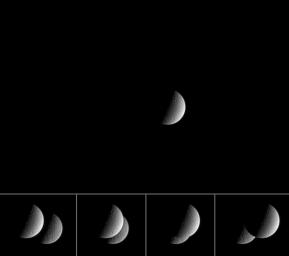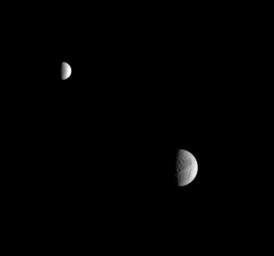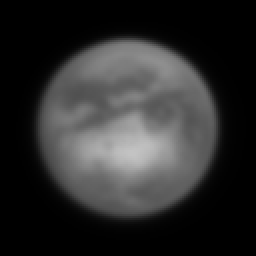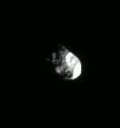Friday, March 04, 2005
This week's Cassini Status report is out. The report covers the start of the S08 sequence which covers the interval from February 26 through April 8. During sequence S08, Cassini will orbit Saturn twice, have a targetted flyby of Titan and Enceladus, and several non-targetted encounters including Rhea and Tethys. Also this week was the Cassini Project Science Group meeting in Florence, Italy.
Astronomy and Sky and Telescope Titan Special Issues
The Huygens landing is the cover story of both Astronomy and Sky and Telescope. Haven't read the articles yet and will let you know what I find when I do.
Update: Astronomy magazine's article not only has the official DISR created mosaics, but several mosaics created by Enthusiasts. Just thought that was interesting. Nothing significantly newsworthy, other than the figure that the probe swung less than 3 degrees in the troposphere. Sky and Telescope does have a few additional tidbits. First, according to GCMS team member Sushil Atreya said that GCMS detected 100% CH4 relative humidity at an altitude of 17-20 km, suggesting a thick cloud or haze layer at that altitude.
Update: Astronomy magazine's article not only has the official DISR created mosaics, but several mosaics created by Enthusiasts. Just thought that was interesting. Nothing significantly newsworthy, other than the figure that the probe swung less than 3 degrees in the troposphere. Sky and Telescope does have a few additional tidbits. First, according to GCMS team member Sushil Atreya said that GCMS detected 100% CH4 relative humidity at an altitude of 17-20 km, suggesting a thick cloud or haze layer at that altitude.
Thursday, March 03, 2005
New ISS Movie: Cassini's Private Eclipse

As a followup to a report last Wednesday, CICLOPS has released a new movie showing a mutual event between Dione (in the foreground) and Rhea (800,000 km in the background). While Rhea is much larger than Dione, the distance between the two causes them to appear to have the same angular size. This also caused the initial confusion as to which moon was the background moon, first thought to be Tethys.
New Mimas Movie: Mimas on the Move

This is the first of two movies showing Saturn's moons released today. In this movie (one frame of which shown above), Mimas is seen along a small part of its orbit. Motion is made obvious by the changing aspect of the background rings. The non-circular nature of the limb is due to the large crater Herscel being on the limb in this view.
New Tethys and Enceladus Image: Ice Orbs

This newly released frame from CICLOPS shows Enceladus and Tethys in the same narrow angle frame. This image was taken in late January and is the first of many such compositions now that Cassini is orbiting in Saturn's equatorial plane and in the orbital plane of most of Saturn's major moons.
Wednesday, March 02, 2005
New Huygens Distant Panorama by Rene Pascal
Rene Pascal has posted a new panorama of Huygens images using the highest altitude usable side-looking images he could find. This new panorama really helps in filling in knowledge gaps in the geography of the Huygens landing site region, particularly to the south. Based on this mosaic, I have revised my own estimate of where Huygens landed (Larry, you were right, I was wrong, I should have known better, I'm sorry, though it is farther east than where you had it...). The mosaics seem to confirm that Huygens landed just south off the eastern tip of the large bright region centered around 10 South, 210 West.
One very interesting discovery in this mosaic are two roughly east-west, dark parallel lineaments on the other side of the bright island/peninsula from the landing site. Obviously it is a bit difficult to determine the nature of these from these images, but certainly tectonics would be the first guess. The bright features within the dark terrain seem to focused mostly around the margin of the terrain, maybe former bright terrain that has been been eroded back to the current "shoreline".
One very interesting discovery in this mosaic are two roughly east-west, dark parallel lineaments on the other side of the bright island/peninsula from the landing site. Obviously it is a bit difficult to determine the nature of these from these images, but certainly tectonics would be the first guess. The bright features within the dark terrain seem to focused mostly around the margin of the terrain, maybe former bright terrain that has been been eroded back to the current "shoreline".
Raw Images of the Day
Every so often, I like to update readers on some of my favorite new raw images as they show up on the JPL raw images page. The images often show interesting features (which is why Enceladus rarely makes an appearance since albedo and topographic variations are so muted on the 10 km scale) or have nice compositions (multiples moons, etc). So without further ado:
Correction: That is not Saturn in the background. I was kinda thrown off by the full on anti-Saturnian hemisphere view of Tethys.
- Odysseus crater is prominent in this shot of Tethys against Saturn's night side
- Interesting topography and albedo on Rhea north of Izanagi
- Two images of Iapetus' Cassini Regio here and here
- Dione's Padua Linea
Correction: That is not Saturn in the background. I was kinda thrown off by the full on anti-Saturnian hemisphere view of Tethys.
Astrobiology Magazine: Investigating Titan's Surface
As a followup to one of my first posts on this blog, Astrobiology Magazine has posted the first part of a four part series of an edited transcript from a talk Jonathan Lunine gave at the NASA Director's Telecon in late January. A lot of useful information there, particularly for those looking for a wrap-up of the Huygens mission and the Ta and Tb flybys.
For those who can't stand edited transcripts, if you have RealPlayer, why not listen to the talk? Or for those who don't have the time to read the edited transcript and just want the nuts and bolts, read my summary.
Thanks to imran at the MER forum for the heads up.
For those who can't stand edited transcripts, if you have RealPlayer, why not listen to the talk? Or for those who don't have the time to read the edited transcript and just want the nuts and bolts, read my summary.
Thanks to imran at the MER forum for the heads up.
Lack of Updates
It's been quiet lately on the Titan news front now that we are in the lull between flybys. However the month of March does promise big news events that will be covered on this blog. Next Wednesday, Cassini will perform its second of four close flybys of Enceladus on the heals of a very successful encounter last month. Hopefully this second encounter will be just as successful. The Lunar and Planetary Sciences Conference starts on March 14 and runs until the 18th. I will be at the conference to present a poster and will post news regarding any interesting talks and poster from the conference. Finally, March 31 brings another Titan flyby. This time, we will actually look at some place different.
Tuesday, March 01, 2005
EGU Abstracts Posted
Abstacts for the European Geosciences Union General Assembly 2005 have been posted online. The conference takes place April 24-29 in Vienna, Austria. The abstacts for this conference are not nearly as detailed as those for LPSC but some slight nuggets of info can be gleaned from them. Here are a few interesting ones
- Sotin et al. describes geologic results from VIMS. They note a circular feature that may be an impact crater.
- Schwingenschuh et al. describes "fluctuations of the electric field up to 10 kHz" from the Permittivity, Wave, and Altimetry experiment on HASI found below 140 km.
- Teanby et al. describes work using CIRS to determin latitudinal variations in HCN in Titan's stratosphere. They find that abundances increase, indicative of downwelling in the north polar region.
- Iess et al. describes estimates for Iapetus' mass. Their density for Iapetus based on the two recent encounters is 1.106 cm/m3
- McCord et al. reports on composition variations on Titan using the VIMS instrument. Through the spectral windows available to them, McCord et al. has identified water ice as a surface component. In addition, they note differences in spectual properties at a very bright region centered around 26S, 118W (seen by ISS in the bottom half of this released image).
- Rannou et al. describes their circulation and how it tackles the problem of the strong extinction inversion layer in the troposphere. They suggest "that ethane and methane form clouds on aerosols and produce an extinction inversion layer by a strong rainout process".
New Small Satellites Image: Flock of Moons

CICLOPS has released this newly processed view of three of Saturn's small, inner satellites: (from right to left) Pandora, Janus, and Prometheus. Each of these moons are considered "ring moons" for their influence on the orbital paths of Saturnian ring particles. Janus, the large moon in the center of this image, nearly shares and in fact swaps orbits every four years with a slightly smaller moon named Epimetheus. The next swap is scheduled for February 2006. The moons Pandora and Prometheus act as "shepards" to the the thin F ring, keeping ring particles in the ring.
Monday, February 28, 2005
Cassini Significant Events for 02/17/05 - 02/23/05
The Cassini Significant Events report for last week is out and discusses spacecraft events for the week following the T3 flyby and the Enceladus non-targeted flyby.
Sunday, February 27, 2005
Titan's Cloud-Free Skies Continue

A group of astronomers at the Keck Telescope on Hawaii's Big Island led by Antonin Bouchez captured this image of Titan using a filter sensitive to infrared light at around 2 microns, a relatively "clear" methane window. Keck images of Titan this year have generally shown a cloud-free atmosphere. Clouds during this time of Titan's year are generally focused in the southern polar latitudes between 70S and 90S and in the southern mid-latitudes near 40S. However, lately, fewer and fewer clouds have been seen. Only a couple of small south polar clouds were seen during the T3 flyby by Cassini. It is still unclear whether we are just getting unlucky lately in trying to look for clouds or whether Titan is in the middle of somekind of seasonal climate change as Titan approaches the August 3, 2009 vernal equinox.
On a sidenote, Cassini observed Titan in the clear filter at around this same time.
Update: I should have made it clear that this image was taken on February 25.
Hyperion's crater

Hyperion's large crater (when compared to its size) continues to rotate into view in this new Cassini raw image.

